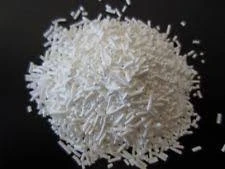
e1420 food additive
Understanding E1420 The Food Additive
Food additives play a crucial role in the modern food industry, serving to enhance flavors, improve the texture, increase shelf life, and ensure food safety. Among those additives is E1420, known legally as Starch Acetate. While it may not be as widely recognized as some flavor enhancers or preservatives, E1420 is significant within various food applications.
What is E1420?
E1420, or Starch Acetate, is derived from starch through a modified process that involves acetylation. This modification alters the physicochemical properties of starch, transforming it into a more versatile ingredient that can play multiple roles in food processing. Primarily, E1420 is employed as a thickener, emulsifier, and stabilizer, making it a popular choice in various food products.
Functions of E1420 in Food Products
One of the main functions of E1420 is as a thickening agent. When used in sauces, soups, and gravies, it helps achieve a desirable texture, enhancing mouthfeel and overall sensory experience. Its gelling properties, resulting from its modified starch structure, allow it to create a stable viscosity even when subjected to heat or mechanical stress.
E1420 also acts as an emulsifier. In products such as salad dressings or mayonnaise, it aids in combining water and oil, preventing separation and ensuring a uniform product. This characteristic is particularly valuable in processed foods, where the appearance and texture are critical for consumer acceptance.
Moreover, E1420 enhances the shelf life of products by acting as a stabilizer. Many processed foods are prone to texture changes over time due to moisture loss or ingredient separation. Starch Acetate helps to maintain product integrity throughout storage, thus reducing waste and improving consumer satisfaction.
e1420 food additive

Safety and Regulatory Status
The safety of food additives such as E1420 is regulated by international and national food safety authorities. In the European Union, for instance, E1420 is approved for use in food products, subject to specific guidelines and maximum allowable concentrations. Regulatory assessments indicate that when consumed within the prescribed limits, E1420 poses no significant risk to human health.
In the United States, the Food and Drug Administration (FDA) recognizes E1420 as Generally Recognized As Safe (GRAS), which allows its use in various food products without the need for pre-market approval. This status is granted based on a substantial amount of scientific evidence demonstrating its safety for human consumption.
Applications of E1420
E1420 finds its application in a variety of food products. The additive is commonly used in processed cheeses, where it gives the cheese a smooth consistency and improves meltability. Additionally, it is present in baked goods, where it helps retain moisture and improve texture, contributing to a softer and more appealing product.
Snacks, such as extruded or puffed products, also benefit from E1420 due to its ability to enhance crunchiness while maintaining structural integrity. Furthermore, E1420 can be found in dairy products, sauces, and dressings, all of which utilize its thickening and emulsifying properties to achieve desirable qualities.
Conclusion
In conclusion, E1420, or Starch Acetate, is an important food additive that serves multiple functions in the food industry. Its roles as a thickener, emulsifier, and stabilizer make it versatile across various products, contributing to the quality and shelf life of processed foods. As with any food additive, understanding its uses and safety aspects is crucial for consumers and producers alike. With ongoing research and development, E1420 continues to be a valuable ingredient, ensuring that food products meet the expectations of quality and safety in today’s market. While it may not be a household name, its impact on the food we consume is undeniable, representing the complexity and innovation in food technology.
-
Sodium Dichloroisocyanurate Safety Handling ProtocolsNewsJul.29,2025
-
Mining Chemicals for Copper Extraction Processes GuideNewsJul.29,2025
-
Fertilizer for Sale Shipping and Storage TipsNewsJul.29,2025
-
Dimethyl Disulfide as Sulfurizing AgentNewsJul.29,2025
-
Benzotriazole Safety Data Handling and Storage GuidelinesNewsJul.29,2025
-
Ammonium Bicarbonate Safety Handling Storage GuidelinesNewsJul.29,2025
-
The Transformative Role Of Trichloroisocyanuric Acid in Water TreatmentNewsJul.23,2025
Hebei Tenger Chemical Technology Co., Ltd. focuses on the chemical industry and is committed to the export service of chemical raw materials.
-

view more DiethanolisopropanolamineIn the ever-growing field of chemical solutions, diethanolisopropanolamine (DEIPA) stands out as a versatile and important compound. Due to its unique chemical structure and properties, DEIPA is of interest to various industries including construction, personal care, and agriculture. -

view more TriisopropanolamineTriisopropanolamine (TIPA) alkanol amine substance, is a kind of alcohol amine compound with amino and alcohol hydroxyl, and because of its molecules contains both amino and hydroxyl. -

view more Tetramethyl Thiuram DisulfideTetramethyl thiuram disulfide, also known as TMTD, is a white to light-yellow powder with a distinct sulfur-like odor. It is soluble in organic solvents such as benzene, acetone, and ethyl acetate, making it highly versatile for use in different formulations. TMTD is known for its excellent vulcanization acceleration properties, which makes it a key ingredient in the production of rubber products. Additionally, it acts as an effective fungicide and bactericide, making it valuable in agricultural applications. Its high purity and stability ensure consistent performance, making it a preferred choice for manufacturers across various industries.











